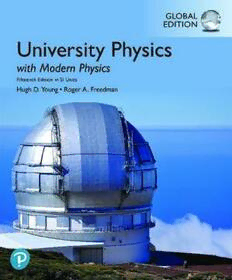Table Of ContentPractice makes perfect: Guided
practice helps students develop
into expert problem solvers
The new 15th Edition of University Physics with Modern Physics, in SI units,
draws on data insights from hundreds of faculty and thousands of student users to
address one of the biggest challenges for students in introductory physics courses:
seeing the connections between worked examples in their textbook and related
homework or exam problems. This edition offers multiple resources to address
students’ tendency to focus on the objects, situations, numbers, and questions posed
in a problem, rather than recognizing the underlying principle or the problem’s
type. Mastering™ Physics gives students instructional support and just-in-time
remediation as they work through problems.
Guided practice features to help . . .
NEW! Worked
Example
Key Concept
statements
appear at the end
of every example,
providing a brief
summary of the
key idea used in
the solution to
consolidate what
was most important
and what can be
broadly applied to
other problems,
helping students
identify strategies
that can be used in
future problems.
P. 232
NEW! Key Example Variation Problems in
the new Guided Practice section at the end of each
chapter are based on selected worked examples.
They build in difficulty by changing scenarios,
swapping the knowns vs. unknowns, and adding
complexity and/or steps of reasoning to provide
the most helpful range of related problems that
students must use the same basic approach to solve.
Assignable in Mastering Physics, these “warm-up”
exercises help students build problem-solving skills.
P. 253
. . . develop problem-solving skills
Scaffolded
Bridging
Problems now
follow the Key
Example Variation
Problems in the Guided
Practice section and
help students move
from single-concept
worked examples
to multiconcept
homework problems.
P. 699
NEW! Bridging
Problem Tutorials,
now assignable in
Mastering Physics,
walk students through
the problem-solving
process and provide
links to the eText and
detailed Video Tutor
Solutions. In the Study
Area in Mastering,
these Video Tutor
Solutions, as well as
ones for every Worked
Example in the book,
provide a virtual
teaching assistant on a
round-the-clock basis.
Develop students’ conceptual
understanding of physics . . .
Test Your Understanding
questions at the end of most
sections let students check their
grasp of the material and use a
multiple-choice or ranking-task
format to probe for common
misconceptions. The answers to
these questions are now provided
immediately after the question in
order to encourage students to
try them.
P. 305
NEW! Direct Measurement Videos are short videos that
show real situations of physical phenomena. Grids, rulers, and
frame counters appear as overlays, helping students to make
precise measurements of quantities such as position and time.
Students then apply these quantities along with physics concepts
to solve problems and answer questions about the motion of the
objects in the video. These videos are assignable within Mastering.
. . . even before they come to class
Conceptual
Interactive Pre-
lecture Videos
provide an introduction
to key topics with
embedded assessment
to help students prepare
before lecture and to
help professors identify
students’ misconceptions.
These videos are assignable
within Mastering.
NEW! Quantitative
Pre-lecture Videos
now complement
the conceptual
Interactive Pre-lecture
Videos designed to
expose students to
concepts before class
and help them learn
how problems for a
specific concept are
worked. These videos
are assignable within
Mastering.
Reach every student . . .
NEW! University Physics with Modern Physics, in SI units is now
available in Pearson eText. Pearson eText is a simple-to-use, personalized
reading experience available within Mastering. It allows students to easily
highlight, take notes, and review key vocabulary all in one place—even when
offline. Seamlessly integrated videos engage students and give them access
to the help they need when they need it. Pearson eText is available within
Mastering when packaged with a new book or as an upgrade students can
purchase online.
. . . with Mastering Physics
Dynamic Study
Modules in Mastering
Physics help students
study effectively—and
at their own pace—by
keeping them motivated
and engaged. The
assignable modules rely
on the latest research
in cognitive science,
using methods such as
adaptivity, gamification,
and intermittent rewards,
to stimulate learning and
improve retention.
The Physics Primer
refreshes students’ math
skills in the context of
physics and prepares
them for success in the
course. These tutorials
can be assigned before
the course begins or
throughout the course as
just-in-time remediation.
They utilize videos, hints,
and feedback to ensure
that students can practice
and maintain their
math skills, while tying
together mathematical
operations and physics
analysis.
Instructor support you can rely on
University Physics with
Modern Physics includes a full
suite of instructor support materials
in the Instructor Resources area in
Mastering Physics. Resources include
accessible PowerPoint lecture outlines;
all annotated equations and problem-
solving strategies; all figures, photos,
tables, and end-of-chapter elements
from the text; simulations; plus a
solutions manual and test bank.
Instructors also have access to Learning Catalytics. With Learning Catalytics, you’ll hear from every student when
it matters most. You pose a variety of questions that help students recall ideas, apply concepts, and develop critical-
thinking skills. Your students respond using their own smartphones, tablets, or laptops. You can monitor responses
with real-time analytics and find out what your students do—and don’t—understand. Then, you can adjust your
teaching accordingly and even facilitate peer-to-peer learning, helping students stay motivated and engaged.
SEARS AND ZEMANSKY’S
UNIVERSITY PHYSICS
WITH MODERN PHYSICS
FIFTEENTH EDITION IN SI UNITS
HUGH D. YOUNG
ROGER A. FREEDMAN
University of California, Santa Barbara
CONTRIBUTING AUTHOR
A. LEWIS FORD
Texas A&M University
SI CONVERSION BY
KATARZYNA ZULETA ESTRUGO
École Polytechnique Fédérale de Lausanne

